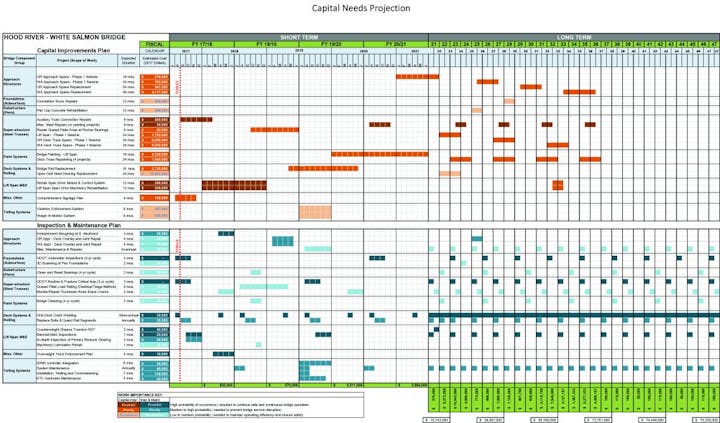Bridge Replacement Project
PLEASE NOTE: The bridge replacement project website is now live! To view the most up-to-date information, please go to: https://hoodriverbridge.org/ . Information below may be out of date at the time of your visit.
Project Overview
The outdated bridge connecting White Salmon and Hood River must be replaced. With narrow lanes, lack of safety shoulders, difficult barge navigation, and no bike or pedestrian path, the bridge does not meet our current needs. In addition, the existing bridge is not ready for an earthquake.
A new bridge would improve the movement of people and goods across the Columbia River in our part of the Gorge. The proposed replacement bridge facility would address problems with river navigation, vehicle travel, pedestrian/bicycle connections, and safety. A new bridge also would support a thriving economy and livable communities.
The Hood River Interstate Bridge Replacement Project is regionally and nationally significant because the bridge provides one of only three Columbia River crossings in Columbia River Gorge National Scenic Area (NSA). The Columbia River Gorge NSA encompasses an 85-mile stretch of the Columbia River in Oregon and Washington.
The region is served by two east-west National Highway System (NHS) corridors: Interstate-84 in Oregon and SR-14 in Washington. The two highways and 28 communities along the river are connected by three bridges, each located more than 20 miles apart, with the Hood River Bridge situated centrally. (On March 3, 2016, at the request of WSDOT and ODOT, USDOT/FHWA named the Hood River Interstate Bridge an NHS facility.) This project will significantly improve performance of the NHS system by replacing the Hood River Interstate Bridge. Annually, 3.6 million vehicles cross the bridge and there has been a 2% annual growth in crossings in recent years.
The nearly 100-year old steel truss bridge is structurally deficient, functionally obsolete with sufficiency rating of less than 10, and is nearing the end of its serviceable life. The potential failure or closure of the bridge would “…have severe social and economic impacts on the interdependent, bi-state communities” of the Columbia River Gorge National Scenic Area, as stated in the Summary to the Draft EIS of the SR-35 Columbia River Crossing Study completed in 2003.
The current bridge’s 246 foot navigational channel under the lift span is poorly aligned, insufficient and dangerous for the commercial cargo barges navigating the federal inland waterway, as evidenced by a September 2015 barge tow allision with the bridge’s north lift span pier that caused at least $1.1 million in damage and has resulted in the closure of the lift span until repairs can be completed; estimated to be summer, 2016. Over 9 million tons of commercial cargo traveled under the bridge’s lift span in 2012 , at least 30% of the total cargo barged for import/export on the inland navigation route from Portland/Vancouver to Lewiston, Idaho.
The Hood River Interstate Bridge is one of the most challenging bridges on the Columbia River System for barge operators. Only one vessel can navigate the opening at a time, despite the fact that barge traffic on the lower Columbia River continues to grow with barge operators annually hauling more than 3 million tons of wheat and barley, and millions of barrels of petroleum products, logs and wood chips.
Construction of a new, modern structure to replace the old bridge would provide for the multi-modal transportation of people and goods across the Columbia River between the Bingen and White Salmon, Washington and Hood River, Oregon communities. The overall need for the project is to rectify current and future transportation inadequacies and deficiencies associated with the existing Hood River/White Salmon Interstate Bridge. Specific needs addressed by the project are related to capacity, system linkage, transportation demand, social demands, economic development, modal interrelationships, navigational conflicts, safety, and existing bridge, bridge roadway, and navigational deficiencies.
Built in 1924, the steel deck bridge is structurally deficient for vehicle freight crossings, with only two very narrow (9′ 4.75′ wide), shoulder-less lanes. The bridge is weight restricted and cannot accommodate modern vehicle freight hauling truck configurations as well as some emergency response vehicles. The bridge structure is also insufficient for the marine barge tow freight navigating the mere 246 feet horizontal span on this important inland gateway for U.S. wheat, soy, wood products and mineral bulk exports. The bridge is not seismically retrofit, is functionally obsolete and weight and dimensionally restricted for large trucks, yet still remains a primary freight route recently listed on the National Highway System and used by truckers moving fruit, wood products, rock and gravel, and the locally manufactured unmanned aerial vehicles (UAVs) and component parts.
The bridge has no bicycle/pedestrian facilities and cannot support the addition of such facilities. This is particularly problematic since it prohibits cycle commuting between Washington and Oregon and also fails to serve the recreational interests of cyclists and pedestrians drawn to the NSA. The Draft EIS completed in 2003 estimated the current bridge’s serviceable life to be approximately 30 years. Residents, businesses, and commuters who live in economically disadvantaged Klickitat County, Washington and work, shop, and receive services in Oregon are concerned about the safety and service life of the bridge. The nearest alternate crossings of the Columbia River are located more than 20 miles away to the east and west. This project will complete the final pre-construction activities associated with the construction of a new interstate bridge.
To learn more about the bridge replacement project, please contact the Bridge Replacement Project Director Michael Shannon via email to mwshannon@hntb.com.

